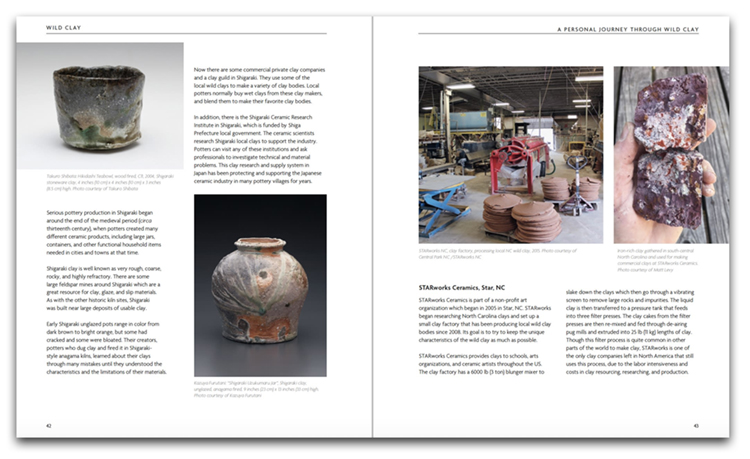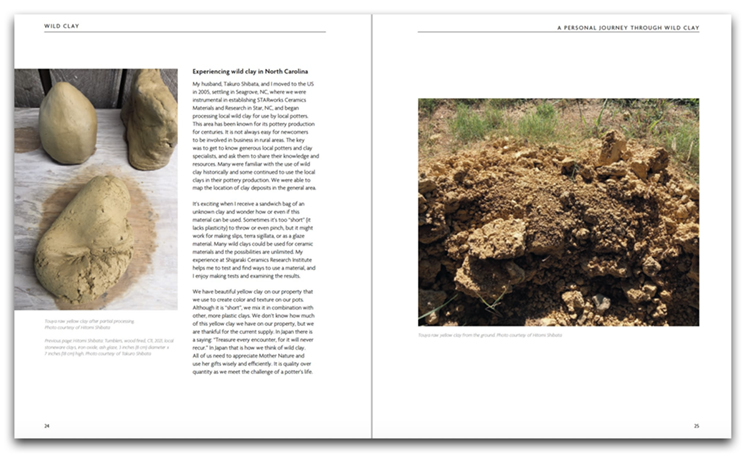The subtitle of this book leaves no doubt about its content: «Creating ceramics and glazes from natural and found resources», and the authors do not disappoint, offering the most comprehensive guide on the subject published to date.
Traditionally, all forms of craft creation have been directly linked to the use of local materials. This is what logic dictates, but it is also what, throughout history, has been one of the elements in the creation of different cultural identities. In ceramics, this is evident in traditional pottery: each of the original productions from every place in the world had, at the very least, the exclusivity of the clay used, and, until the advent of industrial production of clays and glazes, it was practically impossible to find two identical clays in different places.
Today, most ceramists use raw materials and clays marketed by large companies. In the case of urban environments this is understandable, but any ceramist knows that, just by taking a walk in the countryside, he can find materials that bring uniqueness to his work.
But it is not always easy to use these «wild» raw materials, you have to have specific ways of working and, in addition, you have to know what your objectives are. And this is what this book, written by three potters living in one of the areas of the United States with the greatest ceramic tradition, brings us. According to the authors, the intention of using «wild» clays is not to achieve the perfect paste, but to give the ceramic work an exclusive character, which tells different stories: about the potters, the materials or the processes.
Matt Levy, Takuro Shibata and Hitomi Shibata give us their ways of working, tricks for finding clays or raw materials in nature, testing systems (mostly trial and error), how to process the materials and how we can integrate them into our own way of working.
the intention of using «wild» clays is not to achieve the perfect paste, but to give the ceramic work an exclusive character
Reading through these pages we can see that it is often simpler than we imagine, although it can be laborious, as we may have to do a lot of testing to find the right proportion of materials. But the result will be worth it, as we will get ceramics that we will be able to recognise as ours in every way.
The content of the book takes us through the different knowledge we need to have to get there, from understanding the ecology and geology of the soil, the processes or the necessary tests. But it also helps us to understand that, if we do not get the materials in our environment that allow us to create the right ceramic claybody for our work, we can instead get unique engobes or glazes with which to bring uniqueness to our work with industrial ceramic claybodies.
Finally, we will find the work of more than thirty potters from all over the world who use this type of materials collected directly from nature (most of whom, moreover, fire them in wood-fired kilns).
Hitomi Shibata is a Japanese ceramist based in Seagrove, North Carolina (USA). She lived and worked as a potter in Shigaraki, an ancient pottery village in Japan, until a Rotary International scholarship brought her to the United States to study ceramics at the University of Massachusetts-Dartmouth. She later moved with her husband to North Carolina to set up a permanent pottery studio and they now build wood-fired kilns together.
Takuro Shibata is a Japanese-born ceramicist based in Seagrove, North Carolina (USA). His interest in ceramics led him to apprentice at a local pottery workshop in Shigaraki, Japan. After visiting the USA with his wife in 2001, many opportunities arose to join ceramic art programmes.
Matt Levy grew up in Flagstaff, Arizona, and studied in Wisconsin and Montana. He has a strong connection to the geology around him and the materials found there are a constant driving force in his practice


INFORMATION:
Wild Clay. Creating Ceramics and Glazes from Natural and Found Resources
Authors: Matt Levy, Takuro Shibata y Hitomi Shibata
Language: English
280 x 220 mm. Hardcover, 176 pages
ISBN: 9781789940923
Price: 36,00 $
Publisher:
Herbert Press – Bloomsbury Publishing PLC.
31 Bedford Avenue,
London, WC1B 3AT
Reino Unido
Web: www.bloomsbury.com
Text: @Wladimir Vivas . Total or partial reproduction by any medium is prohibited unless expressly authorised in writing.